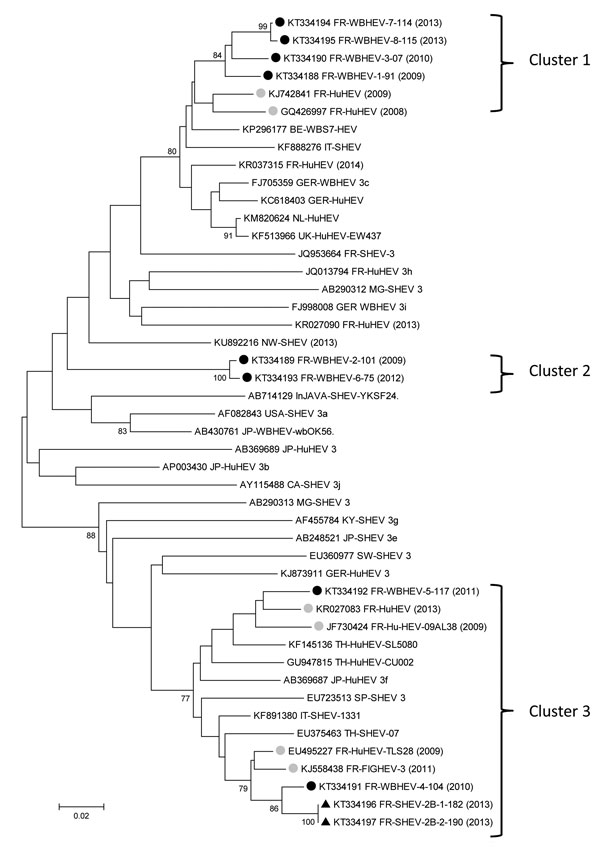Volume 22, Number 12—December 2016
Letter
Possible Foodborne Transmission of Hepatitis E Virus from Domestic Pigs and Wild Boars from Corsica
Figure

Figure. Phylogenetic tree of hepatitis E virus (HEV) sequences identified in samples from wild boars and pigs from Corsica. All 10 HEV sequences (GenBank accession nos. KT334188–KT334197) corresponding to the open reading frame 2 capsid nucleotides 6044–6334 of the reference sequence AF082843, were obtained by Sanger dideoxy sequencing, from wild boars (WB, black circles) or pigs (S, triangles). Sequences were aligned with Muscle (MEGA6, http://www.megasoftware.net) with the 5 closest sequences (retrieved by using BLAST, http://blast.ncbi.nlm.nih.gov/Blast.cgi) and reference sequences (9). The closest HEV sequences from France (gray circles; Hu: human, FIG: figatellu) are identified with their GenBank accession number and year of detection. The tree was constructed by using the neighbor-joining method with a bootstrap of 1,000 replicates. Bootstrap values >70% are indicated on respective branches. Three distinct clusters (1–3) are indicated at right. GenBank reference sequences suggested by Smith et al. for genotype subtyping (9): 3a, AF082843; 3b, AP003430; 3c, FJ705359; 3e, AB248521; 3f, AB369687; 3g, AF455784; 3h, JQ013794; 3i, FJ998008; 3j, AY115488; AB290312, JQ953664, AB369689, AB290313, EU360977, KJ873911, EU723513. Countries of origin of the sequences used are as follows: CA, Canada; FR, France; GER, Germany; InJAVA, Indonesia; IT, Italy; JP, Japan; KY, Kyrgyzstan; MG, Mongolia; NL, the Netherlands; NW, Norway; SP, Spain; SW, Sweden; TH, Thailand; UK, United Kingdom; USA, United States. Scale bar represents nucleotide substitutions per site.
References
- Pavio N, Meng XJ, Renou C. Zoonotic hepatitis E: animal reservoirs and emerging risks. Vet Res. 2010;41:46. DOIPubMedGoogle Scholar
- Thiry D, Mauroy A, Pavio N, Purdy MA, Rose N, Thiry E, et al. Hepatitis E virus and related viruses in animals. Transbound Emerg Dis. 2015;n/a; Epub ahead of print. DOIPubMedGoogle Scholar
- Colson P, Borentain P, Queyriaux B, Kaba M, Moal V, Gallian P, et al. Pig liver sausage as a source of hepatitis E virus transmission to humans. J Infect Dis. 2010;202:825–34. DOIPubMedGoogle Scholar
- Renou C, Roque-Afonso AM, Pavio N. Foodborne transmission of hepatitis E virus from raw pork liver sausage, France. [Erratum in: Emerg Infect Dis. 2015;21:384. ]. Emerg Infect Dis. 2014;20:1945–7.DOIPubMedGoogle Scholar
- Pavio N, Merbah T, Thébault A. Frequent hepatitis E virus contamination in food containing raw pork liver, France. Emerg Infect Dis. 2014;20:1925–7. DOIPubMedGoogle Scholar
- Mansuy JM, Gallian P, Dimeglio C, Saune K, Arnaud C, Pelletier B, et al. A nationwide survey of hepatitis E viral infection in French blood donors. Hepatology. 2016;63:1145–54. DOIPubMedGoogle Scholar
- Rose N, Lunazzi A, Dorenlor V, Merbah T, Eono F, Eloit M, et al. High prevalence of hepatitis E virus in French domestic pigs. Comp Immunol Microbiol Infect Dis. 2011;34:419–27. DOIPubMedGoogle Scholar
- Lu L, Li C, Hagedorn CH. Phylogenetic analysis of global hepatitis E virus sequences: genetic diversity, subtypes and zoonosis. Rev Med Virol. 2006;16:5–36. DOIPubMedGoogle Scholar
- Smith DB, Simmonds P, Izopet J, Oliveira-Filho EF, Ulrich RG, Johne R, et al. Proposed reference sequences for hepatitis E virus subtypes. J Gen Virol. 2016;97:537–42. DOIPubMedGoogle Scholar